- 实验目的
1. 采用C4.5算法建立决策树模型
2. 将每个特征的信息增益率打印输出
3. 输出最后建立的决策树模型结构图(可以用字典结构表示,也可以用matplotlib等图形库绘制出树形图)
- 实验内容:
1、使用np.loadtxt把txt文件中的数据变为ndarray,第一列是编号,在实验中不需要,使用切片去除。同时根据数据集的资料,列出每个属性名。

2、求信息熵。需要统计出总共有多少种类别,以及每类个数,使用字典存储查找快捷方便。按照公式进行计算即可。
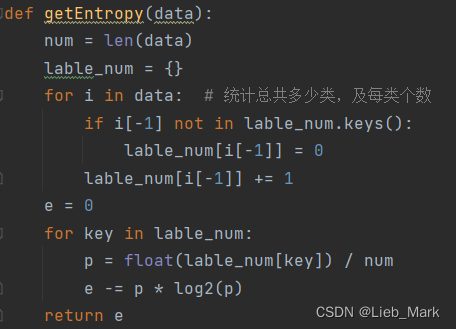
3、根据选定的属性及该属性取值value,对数据集进行筛选,只保留该属性列值为value的行,并且去除该属性列,因为后面还要递归处理,这列还保留的话,可能会在一个分支上多次使用这个属性进行划分。去除列可以使用切片,之后再用np.hstack水平方向合并。

4、给出一个列表,求出其中哪个元素出现的次数最多。可以用于递归的数据只有一种属性,此时为叶节点,类别确定为出现的次数最多的类别。使用内置的collections库中的Counter进行统计并输出。

5、根据课本上的原理进行划分属性的选择,应当计算并选择增益率最大的属性。对每个属性求增益率:使用两层循环,外层枚举属性,内层统计该属性有多少种、占比、固有值。根据公式求出每个的增益率,选取增益率最大的属性作为划分属性。
![]()

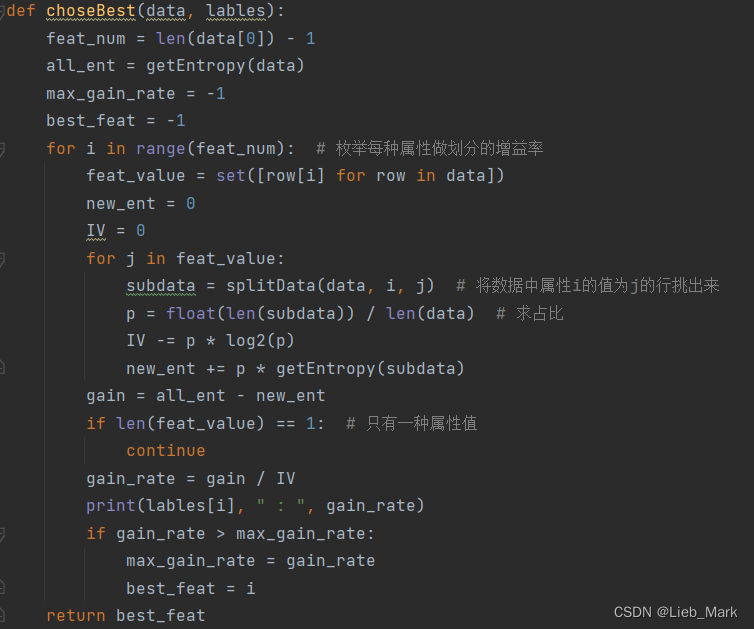
6、根据书上的伪代码创建树。首先是两种特殊情况:如果只有一种类别,那么这个分支的所有样本都属于这个类别,变为叶节点;
![]()
如果样本在A上取值相同,就选择D中样本数最多的类。
![]()
与这两种情况都不相符的话,就要从A中选取增益率最大的属性进行划分,调用上面实现的函数choseBest即可得出。然后根据该属性取值不同,生成不同分支,再递归求解其子树。

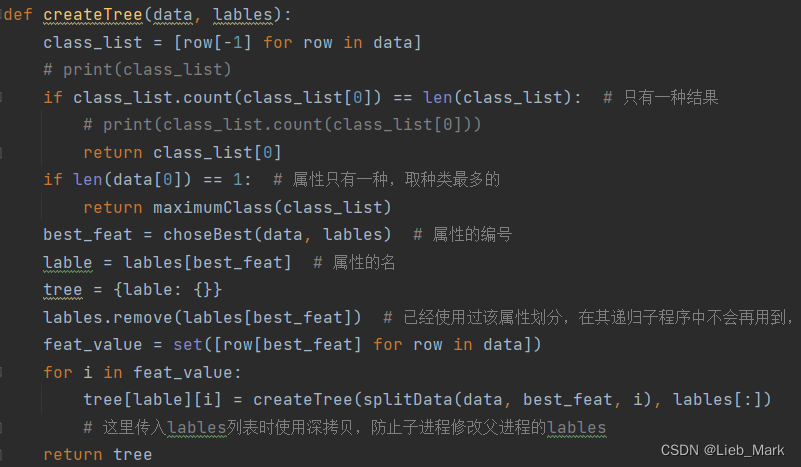
实验中遇到的问题及解决:
在建树的处理过程中,选定了某个属性需要在标签中将其去除,防止与后面的数据对应不上。在递归参数传递时,使用splitData函数选取该属性值相同的样本放在一个节点上,并去除该属性的列。lables的传递需要注意使用切片生成一个新对象或者使用deepcopy出一个新的,否则传递指针导致在子进程中修改lables,父进程出错。
实验结果:
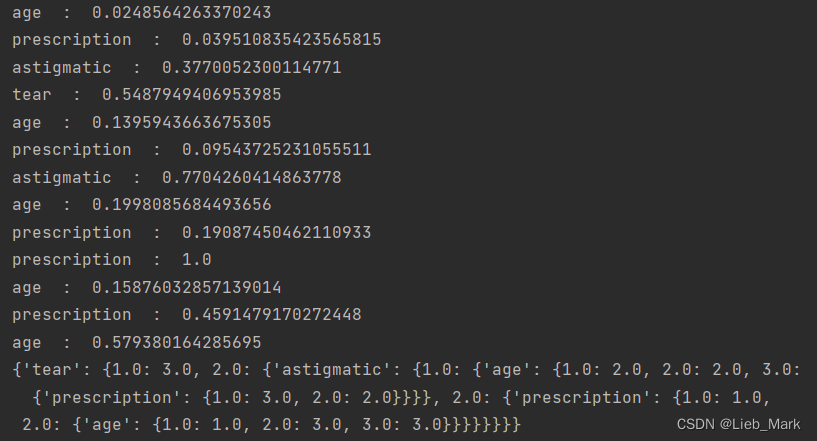
可以看到各个特征的信息增益率,由于决策树是多层的,可能在不同的分支对不同的属性信息增益率不同。但是前四行是第一次选定,可以看到tear的增益率最高,选定其作为划分依据,后面类似,与实验结果吻合。
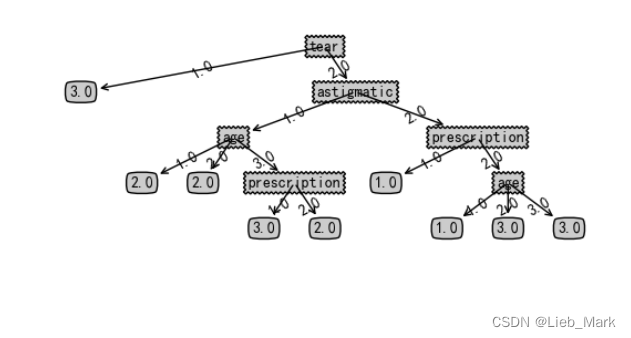
根据资料搜集,可以使用matplotlib进行决策树的绘制,这样更加清晰直观。
- 实验原理:
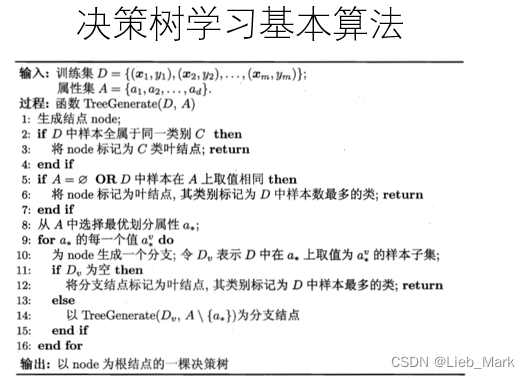
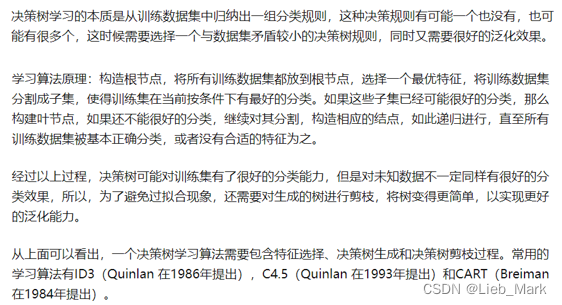
- 心得体会:
通过这次实验我学习了三种决策树的思想以及C4.5算法的具体实现过程,在实践中对这些算法有了更加清晰的理解和掌握。同时还熟悉了信息熵、增益率等概念和决策树具体创建和工作流程以及其合理性。这也是对python数据处理、程序设计的能力考验,有的操作调用方法就可以较快实现,如ndarray的合并、列表求出现次数最多的元素。
在实验中也遇到了因为python的函数传参机制是传递指针,造成递归的子进程修改父进程变量的问题;对于伪代码转换为可执行代码的手足无措;以及学习matplotlib实现决策树的绘制等等。为以后的学习打下坚实的基础。
import numpy as np
from math import log2
import treePlotter
from collections import Counter
def loadData(path):
dataset = np.loadtxt(path)
lable = ['age', 'prescription', 'astigmatic', 'tear']
return dataset[:, 1:], lable
def getEntropy(data):
num = len(data)
lable_num = {}
for i in data: # 统计总共多少类,及每类个数
if i[-1] not in lable_num.keys():
lable_num[i[-1]] = 0
lable_num[i[-1]] += 1
e = 0
for key in lable_num:
p = float(lable_num[key]) / num
e -= p * log2(p)
return e
def splitData(data, classfication, value):
subdata = []
for row in data:
if row[classfication] == value:
subdata.append(np.hstack((row[:classfication], row[classfication + 1:])))
# print(subdata)
return subdata
def maximumClass(class_list):
cnt = Counter(class_list)
max_class = cnt.most_common()[0][0]
return max_class
def choseBest(data, lables):
feat_num = len(data[0]) - 1
all_ent = getEntropy(data)
max_gain_rate = -1
best_feat = -1
for i in range(feat_num): # 枚举每种属性做划分的增益率
feat_value = set([row[i] for row in data])
new_ent = 0
IV = 0
for j in feat_value:
subdata = splitData(data, i, j) # 将数据中属性i的值为j的行挑出来
p = float(len(subdata)) / len(data) # 求占比
IV -= p * log2(p)
new_ent += p * getEntropy(subdata)
gain = all_ent - new_ent
if len(feat_value) == 1: # 只有一种属性值
continue
gain_rate = gain / IV
print(lables[i], " : ", gain_rate)
if gain_rate > max_gain_rate:
max_gain_rate = gain_rate
best_feat = i
return best_feat
def createTree(data, lables):
class_list = [row[-1] for row in data]
# print(class_list)
if class_list.count(class_list[0]) == len(class_list): # 只有一种结果
# print(class_list.count(class_list[0]))
return class_list[0]
if len(data[0]) == 1: # 属性只有一种,取种类最多的
return maximumClass(class_list)
best_feat = choseBest(data, lables) # 属性的编号
lable = lables[best_feat] # 属性的名
tree = {lable: {}}
lables.remove(lables[best_feat]) # 已经使用过该属性划分,在其递归子程序中不会再用到,但是其他分支会用到
feat_value = set([row[best_feat] for row in data])
for i in feat_value:
tree[lable][i] = createTree(splitData(data, best_feat, i), lables[:])
# 这里传入lables列表时使用深拷贝,防止子进程修改父进程的lables
return tree
if __name__ == '__main__':
data, lables = loadData(r'D:\pythonProject\Machine_learning\test3\隐形眼镜数据集\lenses_data.txt')
tree = createTree(data, lables)
print(tree)
treePlotter.createplot(tree)
import matplotlib.pyplot as plt
from pylab import *
mpl.rcParams['font.sans-serif'] = ['SimHei']
"定义文本框和箭头格式"
decisionnode = dict(boxstyle="sawtooth", fc="0.8")
leafnode = dict(boxstyle="round4", fc="0.8")
arrow_args = dict(arrowstyle="<-")
"绘制带箭头的注解"
def plotnode(nodetxt, centerpt, parentpt, nodetype):
createplot.ax1.annotate(nodetxt,
xy=parentpt,
xycoords='axes fraction',
xytext=centerpt,
textcoords='axes fraction',
va='center',
ha='center',
bbox=nodetype,
arrowprops=arrow_args)
def createplot():
fig = plt.figure(1, facecolor='white') # 创建新图形
fig.clf() # 清空绘图区
createplot.ax1 = plt.subplot(111, frameon=False)
plotnode('决策节点', (0.5, 0.1), (0.1, 0.5), decisionnode)
plotnode('叶节点', (0.8, 0.1), (0.3, 0.8), leafnode)
plt.show()
def getnumleafs(mytree):
numleafs = 0
firststr = list(mytree.keys())[0]
seconddict = mytree[firststr]
for key in seconddict.keys():
if type(seconddict[key]).__name__ == 'dict':
numleafs += getnumleafs(seconddict[key])
else:
numleafs += 1
return numleafs
def gettreedepth(mytree):
maxdepth = 0
firststr = list(mytree.keys())[0]
seconddict = mytree[firststr]
for key in seconddict.keys():
if type(seconddict[key]).__name__ == 'dict':
thisdepth = 1 + getnumleafs(seconddict[key])
else:
thisdepth = 1
if thisdepth > maxdepth:
maxdepth = thisdepth
return maxdepth
def plotmidtext(cntrpt, parentpt, txtstring):
xmid = (parentpt[0] - cntrpt[0]) / 2.0 + cntrpt[0]
ymid = (parentpt[1] - cntrpt[1]) / 2.0 + cntrpt[1]
createplot.ax1.text(xmid, ymid, txtstring, va="center", ha="center", rotation=30)
def plottree(mytree, parentpt, nodetxt):
numleafs = getnumleafs(mytree)
depth = gettreedepth(mytree)
firststr = list(mytree.keys())[0]
cntrpt = (plottree.xoff + (1.0 + float(numleafs)) / 2.0 / plottree.totalw, plottree.yoff)
plotmidtext(cntrpt, parentpt, nodetxt)
plotnode(firststr, cntrpt, parentpt, decisionnode)
seconddict = mytree[firststr]
plottree.yoff = plottree.yoff - 1.0 / plottree.totald
for key in seconddict.keys():
if type(seconddict[key]).__name__ == 'dict':
plottree(seconddict[key], cntrpt, str(key))
else:
plottree.xoff = plottree.xoff + 1.0 / plottree.totalw
plotnode(seconddict[key], (plottree.xoff, plottree.yoff), cntrpt, leafnode)
plotmidtext((plottree.xoff, plottree.yoff), cntrpt, str(key))
plottree.yoff = plottree.yoff + 1.0 / plottree.totald
def createplot(intree):
fig = plt.figure(1, facecolor='white')
fig.clf()
axprops = dict(xticks=[], yticks=[])
createplot.ax1 = plt.subplot(111, frameon=False, **axprops)
"使用下两行代码计算树节点的摆放位置,将树绘制在水平方向和垂直方向的中心位置"
plottree.totalw = float(getnumleafs(intree)) # 树的宽度
plottree.totald = float(gettreedepth(intree)) # 树的高度
plottree.xoff = -0.5 / plottree.totalw;
plottree.yoff = 1.0 # 追踪已经绘制的节点位置,以及放置下一个节点的恰当位置
plottree(intree, (0.5, 1.0), '')
plt.show()






















 5164
5164











 被折叠的 条评论
为什么被折叠?
被折叠的 条评论
为什么被折叠?








